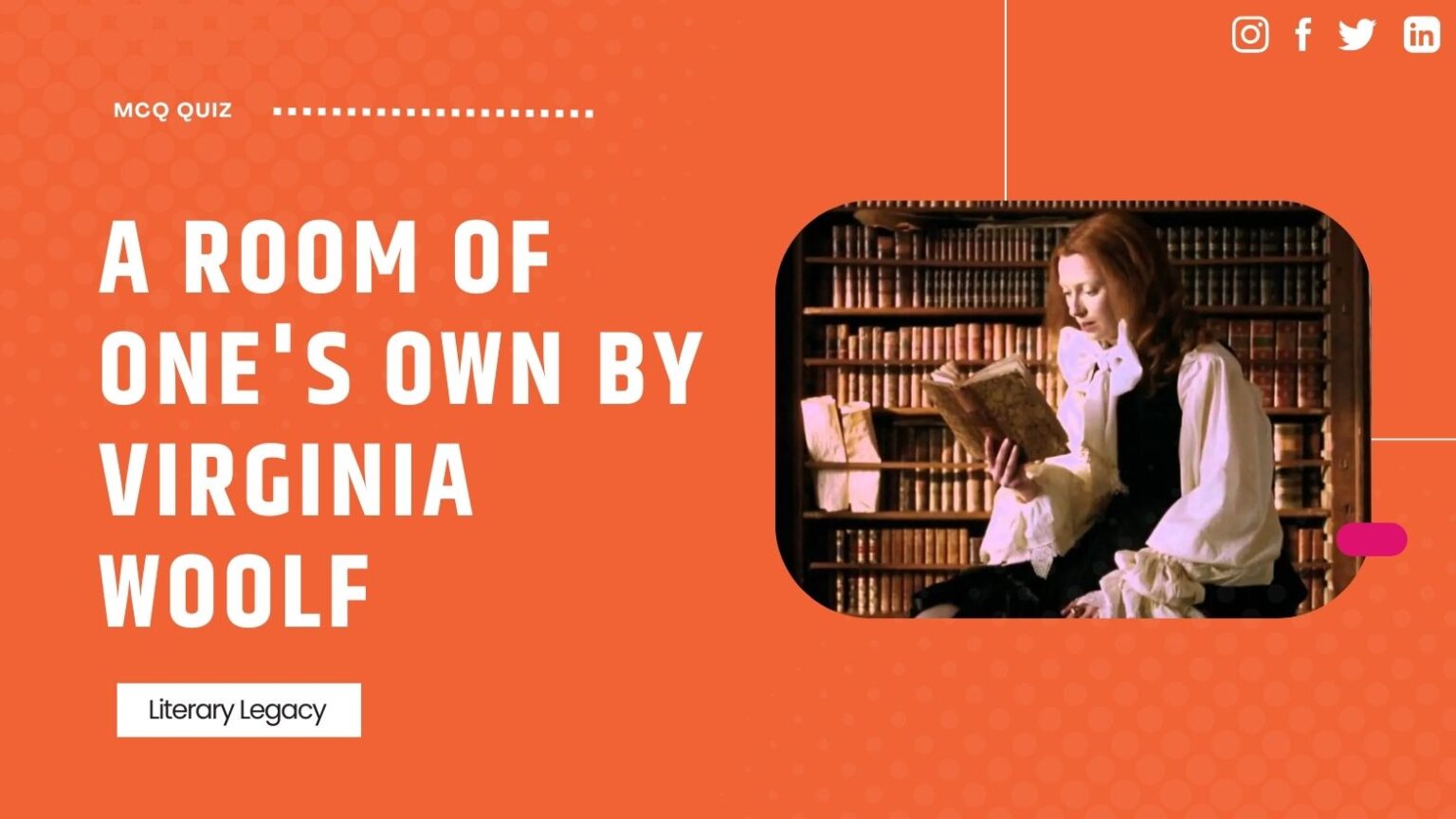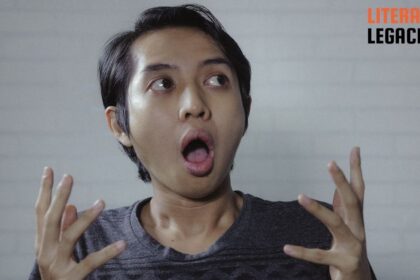1. What is the central thesis of Woolf’s essay as presented in the narrative?
A) A woman must have a supportive community to write fiction.
B) A woman must conform to traditional literary styles.
C) A woman must achieve recognition before she can write.
D) A woman must have money and a room of her own to write fiction.
Answer: (D)
A woman must have money and a room of her own to write fiction.
Woolf argues that financial independence and a personal space are essential for women to create literary works.
2. Who does the narrator of the essay portray as a representation of the struggles faced by intelligent women?
A) Virginia Woolf herself
B) Professor X
C) Judith Shakespeare
D) Mary Seton
Answer: (C)
Judith Shakespeare
Judith Shakespeare is created as an example of the tragic fate that an intelligent woman would face during that time.
3. Which location does the narrator first reflect upon while considering women’s education?
A) Fernham College
B) The University of London
C) Oxbridge College
D) The British Library
Answer: (C)
Oxbridge College
The narrator begins her exploration at Oxbridge College, examining educational disparities.
4. What kind of literature does the narrator find while researching women’s lives?
A) Angry texts authored by men
B) Inspirational and uplifting narratives
C) Biographies written by women
D) Academically detached essays
Answer: (A)
Angry texts authored by men
The narrator discovers that the existing scholarship on women is largely written by men and filled with anger.
5. What does Woolf encourage her audience to do at the conclusion of her essay?
A) To seek permission from male authors to write
B) To abandon traditional methods of writing
C) To only write about women’s struggles
D) To take up the literary tradition bequeathed to them
Answer: (D)
To take up the literary tradition bequeathed to them
Woolf exhorts women to embrace and continue the literary tradition that has been handed down to them.
6. What is the role of the character referred to as ‘The Beadle’ in the essay?
A) A symbolic figure representing male authors
B) A friend of the narrator
C) A supporter of women’s access to education
D) An enforcer of gender restrictions at Oxbridge
Answer: (D)
An enforcer of gender restrictions at Oxbridge
The Beadle serves as a reminder of the societal restrictions placed on women regarding their presence in certain spaces.
7. Which character is described as a student and friend of the narrator?
A) Mary Seton
B) Judith Shakespeare
C) Mary Beton
D) Professor X
Answer: (A)
Mary Seton
Mary Seton is identified as a student at Fernham College and a companion of the narrator.
8. What does the narrator find lacking when researching the lives of women throughout history?
A) Literary works by women
B) Comprehensive historical data
C) Scholarly articles by women
D) Artistic representations of women’s lives
Answer: (B)
Comprehensive historical data
The narrator realizes there is very little historical data available concerning the everyday lives of women.
9. What is ‘Professor X’ a representation of in Woolf’s narrative?
A) A fictional literary character
B) A collective of male scholars on women
C) A mentor for female writers
D) A historical figure in education
Answer: (B)
A collective of male scholars on women
‘Professor X’ symbolizes a combination of male professors whose works the narrator critiques.
10. In what way does Woolf structure her essay?
A) As a fictionalized narrative intertwined with personal reflection
B) Exclusively as a personal memoir
C) In a strictly academic format
D) Through a series of dialogues
Answer: (A)
As a fictionalized narrative intertwined with personal reflection
Woolf uses a partly-fictionalized narrative approach to convey her thoughts and observations on women and fiction.
11. What is the significance of money in the context of women’s writing according to the narrator?
A) Money allows women to travel and gain inspiration.
B) Money secures women’s financial independence and creativity.
C) Money is irrelevant to the creative process.
D) Money has no impact on a woman’s ability to write poetry.
Answer: (B)
Money secures women’s financial independence and creativity.
The narrator emphasizes that financial independence is crucial for women to have the freedom necessary to write.
12. What does the fictional character Judith Shakespeare symbolize in the context of women’s creativity?
A) The equal opportunity women have in the arts.
B) The influence of men on women’s creative works.
C) The lack of social acceptance for women’s genius.
D) The historical success of female writers.
Answer: (C)
The lack of social acceptance for women’s genius.
Judith Shakespeare represents the struggles women face in expressing their creativity due to societal constraints.
13. How does the narrator view the concept of truth in relation to history?
A) History presents a clear and objective account of facts.
B) Truth is absolute and cannot be disputed.
C) Truth is subjective and influenced by personal beliefs.
D) Truth is easily discovered through factual representation.
Answer: (C)
Truth is subjective and influenced by personal beliefs.
The narrator argues that truth is contingent on individual perspectives and experiences.
14. What is meant by an ‘incandescent mind’ according to Woolf?
A) A passionate mind that expresses its artistic vision freely.
B) A mind that only follows traditional artistic norms.
C) A mind concerned only with its own gender identity.
D) A mind filled with doubts and insecurities.
Answer: (A)
A passionate mind that expresses its artistic vision freely.
An incandescent mind refers to a creator who is fully devoted to their artistic vision without self-doubt.
15. How does Woolf associate a woman’s room with her creative potential?
A) A woman’s room represents her limitations in writing.
B) A woman’s room signifies her reliance on family responsibilities.
C) A woman’s room symbolizes the need for solitude and ownership to foster creativity.
D) A woman’s room is irrelevant to her role as a writer.
Answer: (C)
A woman’s room symbolizes the need for solitude and ownership to foster creativity.
The concept of a room of one’s own embodies the essential space for women to cultivate their creativity.
16. What role does the narrator believe interruptions play in women’s writing?
A) Interruptions lead women to prefer writing poetry over novels.
B) Frequent interruptions hinder women’s ability to write successfully.
C) Interruptions do not affect women’s writing at all.
D) Interruptions enhance women’s creativity.
Answer: (B)
Frequent interruptions hinder women’s ability to write successfully.
The narrator argues that constant interruptions make it challenging for women to produce their best work.
17. Which literary figure’s ideas does Woolf connect with the concept of the androgynous mind?
A) Virginia Woolf herself
B) William Wordsworth
C) Samuel Taylor Coleridge
D) Charlotte Brontë
Answer: (C)
Samuel Taylor Coleridge
Woolf relates the idea of an androgynous mind to Coleridge’s views on creativity and artistic expression.
18. What does the narrator suggest about the relationship between financial independence and creativity for women?
A) Women with financial independence write less frequently.
B) Women without financial independence can still write successful novels.
C) Financial independence is inconsequential for artistic expression.
D) Financial independence fosters both creativity and confidence.
Answer: (D)
Financial independence fosters both creativity and confidence.
Financial independence is viewed as essential for women to confidently pursue their artistic endeavors.
19. In the narrator’s view, what is the impact of women’s historical poverty on their literary contributions?
A) Poverty has stifled women’s creativity throughout history.
B) Poverty has led to a wealth of successful literary works.
C) Poverty motivates women to write more frequently.
D) Women have thrived creatively despite economic hardship.
Answer: (A)
Poverty has stifled women’s creativity throughout history.
The narrator argues that the longstanding poverty of women has significantly impeded their ability to write.
20. What does the narrator imply about the role of gender in the creative process?
A) Gender should dictate the themes in writing.
B) Gender should be secondary to the art being created.
C) Gender limitations inspire more profound artistic works.
D) Gender is a crucial factor that enhances creativity.
Answer: (B)
Gender should be secondary to the art being created.
The narrator advocates for transcending gender concerns to focus on the creation of art itself.
21. What consequence does the narrator imply results from women’s historical lack of financial independence?
A) Women can successfully write poetry despite interruptions.
B) Women become less interested in writing.
C) Women’s creativity has been stifled throughout history.
D) Women are forced to rely on male counterparts for creativity.
Answer: (C)
Women’s creativity has been stifled throughout history.
The absence of money leads to the stifling of women’s creativity over time.
22. Which statement best describes the concept of the ‘incandescent mind’ as defined by Woolf?
A) A mind that is overly concerned with its own gender.
B) A mind that critiques the work of other artists.
C) A mind that transmits artistic vision without self-consciousness.
D) A mind that produces art filled with self-doubt.
Answer: (C)
A mind that transmits artistic vision without self-consciousness.
Woolf describes an incandescent mind as illuminated and passionate, focused on art rather than self-doubt.
23. What does the narrator suggest about women and the writing of novels compared to poetry?
A) Women are better at writing poetry than novels.
B) Writing novels accommodates interruptions better than poetry.
C) Women need more time to write novels than men do.
D) Women rarely write novels due to strict societal expectations.
Answer: (B)
Writing novels accommodates interruptions better than poetry.
The ability to start and stop frequently in novel writing makes it more accessible for women.
24. According to the narrator, what is the relationship between truth and opinion?
A) Truth is easily defined and commonly accepted.
B) Truth is subjective and often dependent on circumstances.
C) Truth is absolute, while opinion is subjective.
D) Opinions can always be proven true or false.
Answer: (B)
Truth is subjective and often dependent on circumstances.
The narrator contends that truth is contingent on the individual’s circumstances, rendering it subjective.
25. How does Woolf characterize the societal conditions under which women writers have historically lived?
A) Women lived dependent on men and lacked their own spaces.
B) Women writers were encouraged to pursue poetry in isolation.
C) Women’s creativity flourished in collaborative environments.
D) Women have always enjoyed financial independence.
Answer: (A)
Women lived dependent on men and lacked their own spaces.
Woolf argues that societal conditions forced women into dependency, stifling their creative potential.
26. What does the narrator believe about the opinions expressed in highly controversial subjects?
A) They reflect only personal biases and cannot be substantiated.
B) They are seldom worth discussing due to their complexity.
C) They often reveal universal truths.
D) They can always be proven correct with evidence.
Answer: (A)
They reflect only personal biases and cannot be substantiated.
The narrator argues that highly controversial topics often reflect personal biases rather than objective truths.
27. What effect does Woolf argue the absence of a ‘room of one’s own’ has on women writers?
A) It encourages women to write in public spaces.
B) It perpetuates feelings of inadequacy and dependence.
C) It creates financial challenges for women.
D) It allows women to seek approval from male writers.
Answer: (B)
It perpetuates feelings of inadequacy and dependence.
Without a personal space to write, women struggle with feelings of inadequacy and lack independence.
28. What is the significance of Judith Shakespeare in the context of Woolf’s argument?
A) She symbolizes the achievements of women writers.
B) She showcases the benefits of male mentorship in literature.
C) She illustrates the acceptance of female authors in society.
D) She represents the struggles faced by intelligent women in a male-dominated society.
Answer: (D)
She represents the struggles faced by intelligent women in a male-dominated society.
Judith Shakespeare exemplifies the challenges intelligent women face when denied societal acceptance.
29. What does Woolf say about the impact of insecurity and bitterness on an artist’s work?
A) They enhance the quality of artistic expression.
B) They are necessary for the development of a unique style.
C) They create a more authentic artistic voice.
D) They disrupt the clarity and quality of art produced.
Answer: (D)
They disrupt the clarity and quality of art produced.
Woolf suggests that insecurity and bitterness hinder the ability of artists to produce quality work.
30. What does the narrator suggest is essential for a woman to write fiction?
A) Access to male literary mentors
B) Strong educational background
C) Financial independence and personal space
D) Supportive family environment
Answer: (C)
Financial independence and personal space
The thesis emphasizes that women need both financial resources and a dedicated space to enable their writing.
31. How does the narrator interpret the notion of an androgynous mind in relation to writing?
A) It suggests a need to transcend gender concerns in artistic creation.
B) It indicates that gender determines the quality of writing.
C) It emphasizes the importance of traditional gender roles in art.
D) It implies a preference for male-dominated topics.
Answer: (A)
It suggests a need to transcend gender concerns in artistic creation.
The androgynous mind is described as one that transcends gender and focuses on the art being created.
32. Which group does the narrator critique for wanting to control women’s access to knowledge?
A) Educational institutions
B) Traditionally educated women
C) The aristocracy
D) Male authors
Answer: (A)
Educational institutions
The Beadle’s reminder to stay off the grass signifies institutional control over women’s access to certain privileges.
33. What primary theme does Judith Shakespeare represent in Woolf’s narrative?
A) The lost potential of women in the arts
B) The success of female education
C) The triumph of women’s literature
D) The importance of tradition in writing
Answer: (A)
The lost potential of women in the arts
Judith Shakespeare symbolizes the tragic fate of talented women who are denied opportunities due to societal constraints.
34. How does the narrator gather information about women’s historical experiences?
A) By analyzing literature written by women
B) By reviewing male scholarship and imagining women’s lives
C) Through personal diaries of famous women
D) Through interviews with historians
Answer: (B)
By reviewing male scholarship and imagining women’s lives
The narrator finds limited historical data and resorts to imaginative reconstruction of women’s lives based on male writings.
35. What does the narrator notice about the historical scholarship regarding women?
A) It frequently uses fictional examples.
B) It mostly highlights women’s achievements.
C) It is overly sympathetic and positive.
D) It is predominantly authored by men and filled with resentment.
Answer: (D)
It is predominantly authored by men and filled with resentment.
Most of the scholarship on women noted by the narrator is written by men and reflects an angry tone.
36. What role does the narrator assume in the essay?
A) An authoritative historian
B) A fictionalized author-surrogate
C) A critic of male literature
D) A biographer of famous women
Answer: (B)
A fictionalized author-surrogate
The narrator takes on a fictionalized identity to explore the theme of women and fiction throughout the essay.
37. What advice does Woolf give to her female audience in the conclusion of the essay?
A) Preserve the past without changing it
B) Seek male approval for their works
C) Engage in collaborative writing projects
D) Challenge existing literary traditions
Answer: (D)
Challenge existing literary traditions
Woolf encourages women to take up the literary tradition and contribute to it, pushing for creative evolution.
38. Which character represents the male academic perspective in Woolf’s narrative?
A) The Beadle
B) Professor X
C) Judith Shakespeare
D) Mary Seton
Answer: (B)
Professor X
Professor X epitomizes the amalgamation of male voices critiqued by the narrator as influencing women’s access to knowledge.
39. How does Woolf view the relationship between tradition and women writers?
A) Tradition should be ignored entirely.
B) Tradition is an obstacle to women writers.
C) Tradition provides a foundation for new voices.
D) Women must wholly reject tradition.
Answer: (C)
Tradition provides a foundation for new voices.
Woolf reflects on the importance of tradition as a resource for upcoming women writers, urging them to build upon it.
40. What distinctive challenge does the narrator identify concerning women’s education?
A) It’s focused too much on fiction.
B) It lacks practical applications.
C) It is influenced heavily by men’s narratives.
D) It’s more accessible than men’s education.
Answer: (C)
It is influenced heavily by men’s narratives.
The narrator observes that women’s educational experiences are shaped by male-dominated narratives and expectations.



